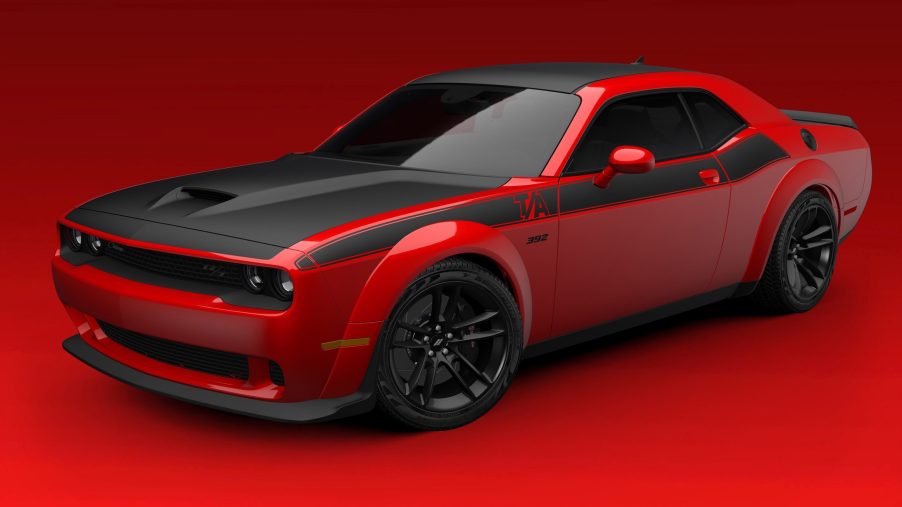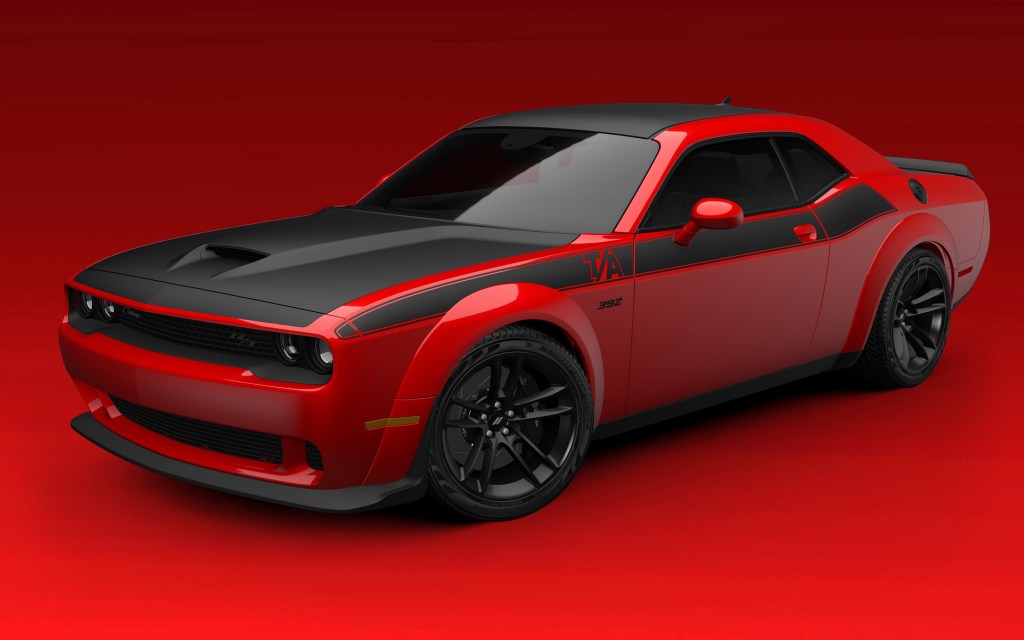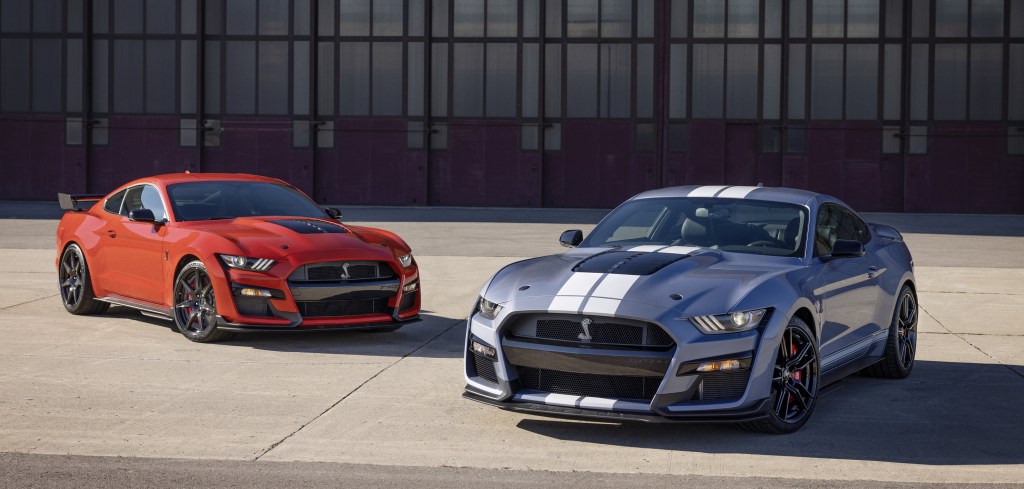
Shelby GT500 vs. Dodge Challenger T/A 392: Dragstrip Showdown
Dodge Challenger T/A 392 vs. Ford Mustang Shelby GT500 drag race article highlights:
- A Dodge Challenger T/A 392 recently went head-to-head with a Shelby GT500 at South Georgia Motorsport Park’s dragstrip
- The Challenger is slower on paper, but the GT500’s launch control has a noticeable delay
- In the end, though, the Shelby out-dragged Dodge’s muscle car, even with a slow start
Before they’re charged with electric assistance, muscle cars are going out with a bang—and serious speed. And while it’s arguably more of a super sports car, the Shelby GT500 is not just peak Mustang, but peak muscle car. Or at least, one of the peaks, because the Dodge Challenger stands tall, too, and not just in Hellcat form. But can the Challenger T/A 392 summon enough muscle to take down the Shelby GT500 at the dragstrip?
The 2022 Dodge Challenger T/A 392 is old-school cool and fast

| 2022 Dodge Challenger T/A 392 | |
| Engine | 6.4-liter V8 |
| Horsepower | 485 hp |
| Torque | 475 lb-ft |
| Transmission | Six-speed manual Eight-speed automatic |
| Curb weight | 4274 lbs (automatic, Car and Driver) |
| 0-60 mph time | 4.2 seconds (automatic, Car and Driver) |
| 1/4-mile time and trap speed | 12.5 seconds @ 116 mph (automatic, Car and Driver) |
Now, if you look on Dodge’s website, you won’t immediately spot the Challenger T/A 392. But that’s because ‘T/A 392’ isn’t this car’s full name. Technically, it’s the Dodge Challenger R/T Scat Pack Widebody with T/A Package. And there’s a lot to unpack here.
First, the ‘T/A’ part. In the 1970s, the SCCA briefly ran the Trans-American racing series, or ‘Trans Am’ for short. This series gave us homologation icons like the original Mustang Boss 302, Camaro Z/28, and the Challenger T/A. As in, ‘Challenger Trans-Am.’
The 2022 Challenger T/A 392—as in, 392 cubic inches, or 6.4 liters—is an homage to that original. It’s not a homologation race car, but it does have a stain-black hood, roof, and decklid, a functional hood scoop, Mopar cold-air intake, and two Air Catcher intakes built into the headlights. It’s just as powerful as the regular Challenger R/T Scat Pack, but its Hemi V8 makes a truly “raucous bellow,” Car and Driver says.
Also, because it’s a Scat Pack Challenger, the T/A 392 has Brembo brakes, lowered and upgraded suspension, launch control, and line lock. And because it’s a Widebody, it has wider wheels and tires as well as fender flares.
It’s not as retro, but the 2022 Shelby GT500 is even faster on paper

| 2022 Ford Mustang Shelby GT500 | |
| Engine | 5.2-liter supercharged V8 |
| Horsepower | 760 hp |
| Torque | 625 lb-ft |
| Transmission | Seven-speed dual-clutch automatic |
| Curb weight | 4183 lbs (base) 4081 lbs (with Carbon Fiber Track Package) |
| 0-60 mph time | 3.4 seconds (street tires, Car and Driver) |
| 1/4-mile time and trap speed | 11.2 seconds @ 132 mph (street tires, Car and Driver) |
Despite its heritage-heavy stripe package, the 2022 Shelby GT500 isn’t nearly as old-school as the Challenger. And you can’t get it with a manual. But as the table above shows, that’s on purpose.
Officially the most powerful road car Ford’s ever made, the Shelby GT500 can humble full-on supercars in a straight line. And that’s without the Carbon Fiber Track Package, which cuts curb weight and adds grippier tires wrapped around carbon-fiber wheels. Well, they’re grippier around a racetrack’s curves. Racing between the lights, the standard Michelin Pilot Sport 4S tires are better than the optional Cup 2s, Car and Driver says.
The Shelby GT500 doesn’t just come armed with a powerful engine, though. It has a carbon-fiber driveshaft, Tremec limited-slip differential, Brembo brakes, and adaptive MagneRide magnetorheological dampers. And, like the Challenger T/A 392, it has launch control and line lock.
So, like the Dodge, it’s ready for the dragstrip.
Racing on a prepped dragstrip is different than on a road or track
On paper, a head-to-head between the Dodge Challenger T/A 392 and Shelby GT500 should go to the Ford. But that’s on the street. Launching on a dragstrip is a little different.
Firstly, dragstrips usually have prepped surfaces. That means, rather than plain asphalt or concrete, the dragstrip is coated with a proprietary chemical mixture. The recipe varies from strip to strip, but the goal is to increase grip and therefore traction. Some mixtures are so sticky that people get stuck to them.
Secondly, there’s the line lock feature. This activates the front brakes to keep the car in place while the rear tires do a burnout. But the burnouts aren’t just to show off (though that is a bonus). They warm up the rear tires so they grip the dragstrip better and give you a better launch. And since both the GT500 and Challenger are RWD muscle cars, they need all the rear grip they can get.
However, although Ford calls it ‘launch control,’ the Shelby GT500’s software works slightly differently than the Challenger’s version. While both muscle cars let you hold them in place while their engines rev, the Dodge’s system actually manages power to minimize wheelspin. The Shelby, though, leaves that up to the driver. Also, Car and Driver noticed “a brief but palpable pause” between releasing the brakes and the car launching.
So, maybe the Challenger isn’t quite as outmuscled as it seems on paper.
On an actual dragstrip, which is faster: the Shelby GT500 or the Dodge Challenger T/A 392?
The actual showdown between these two muscle cars took place at South Georgia Motorsports Park. And unfortunately for the Challenger T/A 392, it couldn’t quite keep up with the Shelby GT500, Motor1 reports.
Both cars ran side-by-side in two consecutive ¼-mile drag races. And even with a slow start on the second run, the GT500 smoked the Challenger. The Shelby ran the ¼-mile first in 10.94 seconds and next in 10.97 seconds, while the Challenger needed 12.01 and 12.06 seconds, respectively. Their trap speeds were noticeably different, too: 127.03 and 126.77 mph for the GT500, and 114.38 and 114.17 mph for the Challenger.
Don’t feel too bad for Dodge, though. At least the Challenger is beating the Mustang on the sales floor.
Follow more updates from MotorBiscuit on our Facebook page.


